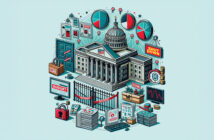President Trump’s so-called “trade war” has gotten a lot of media attention. Tariffs raise prices for consumers, as illustrated by the recent price increase for washing machines, a good that recently received tariff protection. Tariffs on raw materials raise costs for U.S. manufacturers, which cuts into their profits and reduces their competitiveness. Second quarter 2018 earnings for General Motors decreased by three percent due in part to higher aluminum and steel prices resulting from tariffs. The auto maker recently said that proposed tariffs on auto parts might result in layoffs and reduced investment. Tariffs also close markets to domestic producers if foreign countries retaliate. Recently, the European Union retaliated with tariffs on U.S. agriculture products and the U.S. government has pledged $12 billion of taxpayer money to farmers to partially offset the loss of overseas markets after China.
With that said, concern over the “trade war” is largely overblown. The last trade war was caused by the Smoot-Hawley tariff, which was signed into law in 1930. This tariff was substantially larger, and more damaging, than President Trump’s tariffs. Smoot-Hawley raised tariffs by an average of 50 percent on 20,000 imports spanning nearly every country on the globe. Smoot-Hawley resulted in a double-digit decrease in imports, with trade in 1933 being 40 percent lower than in 1929. The stock market crash of October 24, 1929, that many claim to be the start of the Great Depression , coincides with the unexpected passing of the Smoot-Hawley tariff by the U.S. Senate. It then took decades of world trade negotiations to unwind the effects.
In contrast to Smoot-Hawley, President Trump’s tariffs are much more modest, targeting a limited number of goods in a limited number of countries with an average tariff rate that is less than half of the Smoot-Hawley rate. Consequently, the stock market does not appear to be spooked by the tariffs. The Dow Jones Industrial Average is up nearly 800 points over the year. Also consider that the U.S. economy grew by 4.1 percent in the second quarter, (which had not happened since 2014), after growing by 2.6 percent in the first quarter, (which is the best first quarter performance since 2015). Unemployment remains low and job creation robust. The unemployment rate is four percent, which is considered to be “full employment” and at an average of 215,000 new jobs per month, average job growth in 2018 is outpacing 2017. Thus, calling Trump’s tariffs a “trade war,” which harkens us back to the Smoot-Hawley days, is a gross overstatement.
An optimistic view of the president’s trade policies is that they are not designed to reduce the overall level of trade but are part of a larger negotiating strategy to reduce global trade barriers. For instance, the European Union levies a ten percent tariff on imported automobiles. Trump has threatened a 20 percent tariff on imported cars in retaliation. If countries respond by lowering their trade barriers, international trade will be freer than before, improving the U.S. and global economies.





